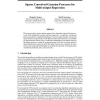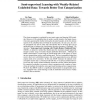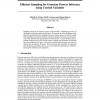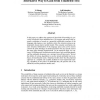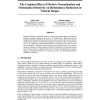NIPS
2008
14 years 29 days ago
2008
We present a sparse approximation approach for dependent output Gaussian processes (GP). Employing a latent function framework, we apply the convolution process formalism to estab...
NIPS
2008
14 years 29 days ago
2008
Recently, fitted Q-iteration (FQI) based methods have become more popular due to their increased sample efficiency, a more stable learning process and the higher quality of the re...
NIPS
2008
14 years 29 days ago
2008
We propose a novel application of Formal Concept Analysis (FCA) to neural decoding: instead of just trying to figure out which stimulus was presented, we demonstrate how to explor...
NIPS
2008
14 years 29 days ago
2008
Spectral clustering is useful for a wide-ranging set of applications in areas such as biological data analysis, image processing and data mining. However, the computational and/or...
NIPS
2008
14 years 29 days ago
2008
The cluster assumption is exploited by most semi-supervised learning (SSL) methods. However, if the unlabeled data is merely weakly related to the target classes, it becomes quest...
NIPS
2008
14 years 29 days ago
2008
For many supervised learning problems, we possess prior knowledge about which features yield similar information about the target variable. In predicting the topic of a document, ...
NIPS
2008
14 years 29 days ago
2008
EEG connectivity measures could provide a new type of feature space for inferring a subject's intention in Brain-Computer Interfaces (BCIs). However, very little is known on ...
NIPS
2008
14 years 29 days ago
2008
Sampling functions in Gaussian process (GP) models is challenging because of the highly correlated posterior distribution. We describe an efficient Markov chain Monte Carlo algori...
NIPS
2008
14 years 29 days ago
2008
In this paper, we address the question of what kind of knowledge is generally transferable from unlabeled text. We suggest and analyze the semantic correlation of words as a gener...
NIPS
2008
14 years 29 days ago
2008
Bandpass filtering, orientation selectivity, and contrast gain control are prominent features of sensory coding at the level of V1 simple cells. While the effect of bandpass filte...
